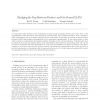Free Online Productivity Tools
i2Speak
i2Symbol
i2OCR
iTex2Img
iWeb2Print
iWeb2Shot
i2Type
iPdf2Split
iPdf2Merge
i2Bopomofo
i2Arabic
i2Style
i2Image
i2PDF
iLatex2Rtf
Sci2ools
RAS
2010
2010
Bridging the gap between feature- and grid-based SLAM
One important design decision for the development of autonomously navigating mobile robots is the choice of the representation of the environment. This includes the question which type of features should be used or whether a dense representation such as occupancy grid maps is more appropriate. In this paper, we present an approach which performs SLAM using multiple representations of the environment simultaneously. It uses reinforcement to learn when to switch to an alternative representation method depending on the current observation. This allows the robot to update its pose and map estimate based on the representation that models the surrounding of the robot in the best way. The approach has been implemented on a real robot and evaluated in scenarios, in which a robot has to navigate in- and outdoors and therefore switches between a landmark-based representation and a dense grid map. In practical experiments, we demonstrate that our approach allows a robot to robustly map environme...
| Added | 30 Jan 2011 |
| Updated | 30 Jan 2011 |
| Type | Journal |
| Year | 2010 |
| Where | RAS |
| Authors | Kai M. Wurm, Cyrill Stachniss, Giorgio Grisetti |
Comments (0)

